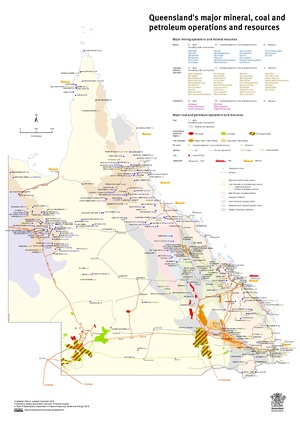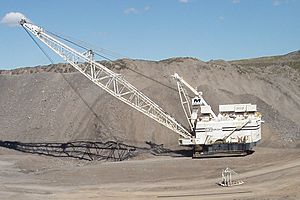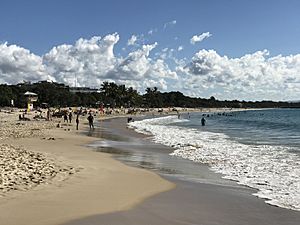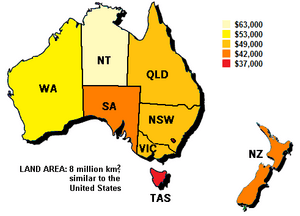Economy of Queensland facts for kids
| Currency | Australian Dollar (A$ or AUD) |
|---|---|
| 1 July – 30 June | |
| Statistics | |
| GDP | A$288.3 billion (2012-13) |
|
GDP growth
|
3.5% (2012-13) |
| 2.5% (2013) | |
|
Labour force
|
2,313,800 (2010-11) |
|
Labour force by occupation
|
Retail trade (11.7%), Construction (11%), Health care & social assistance (10.1%), Manufacturing (8.5%), Education & training (7.6%) |
| Unemployment | 6.2% (2018) |
|
Main industries
|
Mining, tourism, agriculture, financial services |
| External | |
| Exports | A$49.2 billion (2010-11) |
|
Export goods
|
Coal, beef, aluminium, copper, copper ores & concentrates, fertilizers, animal feed, zinc ores & concentrates, lead ores & concentrates, lead |
|
Main export partners
|
|
| Imports | A$41.7 billion (2008-2009) |
|
Import goods
|
Crude petroleum, passenger motor vehicles, refined petroleum, gold, goods vehicles, civil engineering equipment & parts, rubber tyres, treads & tubes, aircraft, spacecraft & parts, furniture, mattresses & cushions, mechanical handling equipment & parts |
|
Main import partners
|
|
| Public finances | |
|
Credit rating
|
|
|
All values, unless otherwise stated, are in US dollars. |
|
The economy of Queensland is the third largest economy in Australia. It creates a big part of Australia's total economic output. Queensland's economy mainly relies on mining, agriculture, tourism, and financial services. The state's main exports are coal, metals, meat, and sugar.
Queensland and Western Australia are often called "resource states." This is because their economies depend a lot on exporting natural resources. These include coal, iron ore, and natural gas. However, Queensland's economy is more varied than Western Australia's. In 2009, Queensland's exports were worth A$65.5 billion.
Brisbane is a very important city for global business. It is one of the top cities in the Asia-Pacific region for its total economic output. Brisbane is strong in areas like mining, banking, insurance, and transportation. It also has strengths in information technology, real estate, and the food business. Many large Australian companies have their main offices in Brisbane. These include Suncorp Group, Virgin Australia, and Flight Centre.
In 2018, over 134,000 international students studied in Queensland. Most of these students were in Brisbane. A large number of them came from countries in Asia.
Contents
Farming and Food Production
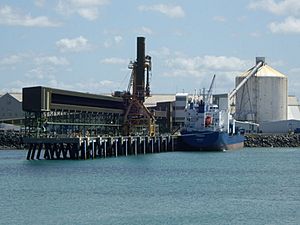
In 2011, Queensland had over 28,000 farms. These farms covered about 81% of the state's land. Sugar cane is the state's biggest farm product. It grows in coastal areas from Far North Queensland to the southern border. Queensland produces 94% of all raw sugar in Australia. This sugar can be sent to customers in the Asia-Pacific region all year. Large storage places at port terminals help with this.
Cattle are raised for beef and sheep for wool in inland areas. Wheat is grown in the Darling Downs region. This area has also seen more mining activity. This has created jobs in construction, but it has also caused disagreements between farmers and mining companies.
The Lockyer Valley is an important area for growing fruits and vegetables. However, long periods of drought are making the local economy change. Farms near Bowen grow Australia's largest winter vegetable crop. Other major crops in Queensland include bananas, cotton, and citrus fruits. Southern coastal areas have a mix of forests and farms.
Mining and Resources
Mining is a very important part of Queensland's economy. In 2006-07, it made up 9% of the state's total economic output. Queensland has large amounts of coal, coal seam gas, and bauxite. It also has some oil shale and natural gas reserves. In 2008-09, Queensland produced 159 million tonnes of coal. This coal was exported to 38 countries. Queensland exports half of the world's coking coal, which is used to make steel.
Other minerals mined in the state include copper, lead, silver, and gold. Dimension stone, which is stone cut for building, is also produced. This includes granite, marble, and sandstone.
Queensland has the largest potential for oil and gas on land in Australia. This is because much of the state has not been fully explored. Oil was found in the southwest in the early 1980s. This led to building an oil pipeline to Brisbane. Gas pipelines also connect users in Mount Isa and Brisbane to the southwest.
Valuable gemstones like sapphire, opal, and chrysoprase are also mined. In 2008-09, Queensland earned A$3 billion from mining royalties.
Coal Seam Gas
The Bowen Basin and Surat Basin are important for Queensland's coal seam gas industry. These areas are under prime farmland, but mining is growing fast. From 2000 to 2010, about 1200 wells were drilled in the western Darling Downs. This number was expected to grow to 20,000 in the next ten years. In 2010, coal seam gas produced 30% of the state's electricity.
Many international energy companies are investing billions of dollars. They want to turn coal seam gas into liquified natural gas (LNG) and export it. This LNG would be shipped from the Port of Gladstone. Farmers in these areas have concerns. They worry about not getting enough payment, access to their land, and new gravel roads on their farms. They also worry about water runoff from drilling sites. Another concern is the millions of tonnes of salt that will come to the surface each year.
Refineries and Ports
One of the world's largest alumina refineries is Queensland Alumina in Gladstone. It was built in 1967. Bauxite, which is used to make aluminium, is brought from Weipa to Gladstone by sea. Australia's largest aluminium smelter, Boyne Smelters, is also in Gladstone.
Near Townsville is a big nickel and cobalt refinery called Queensland Nickel.
Early industries in Queensland relied on seaports to send their products to market. This was before a large rail network was built. The biggest ports in Queensland are the Port of Gladstone, then the Port of Brisbane, and then the Port of Townsville. Some ports in Central Queensland have had long waiting times for ships. For example, in 2007, 50 ships were waiting to be loaded. In 2008, the Federal Government gave Queensland extra money. This was to improve port and rail infrastructure.
State Money and Budget
| Financial year | GSP growth rate (%) |
Average unemployment rate (%) |
|---|---|---|
| 2004-05 | 4.0 | 4.9 |
| 2005-06 | 4.5 | 5.0 |
| 2006-07 | 6.8 | 4.0 |
| 2007-08 | 5.1 | 3.7 |
| 2008-09 | 1.1 | 4.4 |
| 2009-10 | 2.2 | 5.7 |
| 2010-11 | 0.2 | 5.5 |
| 2011-12 | 4.0 | 5.5 |
| 2012-13 | 3.5 | 6.0 |
The Queensland Treasury is the government department that plans how the state spends its money. It also collects taxes and does research. Queensland's economic goals are to have a varied economy and create more jobs. They also want to manage city growth and develop regional areas.
Queensland was expected to spend more money than it earned until 2015-16. This was partly because the prices for coal went down. Less money from the Goods and Services Tax (GST) also contributed to this. Strong population growth has also put pressure on the state's budget. This is because more money is needed for things like roads and schools. These issues led to Queensland losing its top credit rating.
In 2009, Queensland Premier Anna Bligh announced plans to sell some government-owned businesses. These included Queensland Motorways and the Port of Brisbane. This sale was expected to raise A$15 billion. Many people did not agree with this plan. Unions and economists said the sales were not needed and were happening at the wrong time.
Taxes
Queensland used to be known as the state with the lowest taxes. However, it has now fallen to third place compared to other states. From 2002 to 2007, the amount of tax paid per person rose by 70%. Payroll tax is a tax paid by businesses with large wage bills. In 2007-08, this tax made up 26% of Queensland's tax income. Some businesses have called this tax "crippling."
Tourism - People Visiting Places
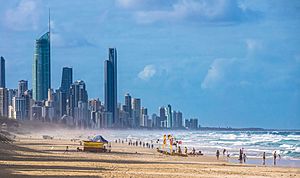
Tourism is very important for the economies of regional areas. It supports thousands of small businesses. Queensland gets the second-highest number of tourists in Australia, after New South Wales. Many international visitors are backpackers and students on working holiday visas.
The tourism industry employs about 5.7% of Queensland's workers. This is about 119,000 people. It also adds 4.5% to the state's total economic output, bringing in A$8.8 billion. Tourism Queensland is the government group that helps develop the state's tourism industry.
Queensland has many different landscapes, a warm climate, and beautiful nature. Because of this, tourism is a leading industry. Millions of visitors from other parts of Australia and other countries visit each year. The industry makes A$8.8 billion annually. It also exports A$4.0 billion annually.
Visitors spend most of their money on accommodation (nearly 22%). They also spend a lot on restaurants and meals (15%), airfares (11%), fuel (11%), and shopping/gifts (11%).
The most popular tourist places in Queensland include Brisbane, the Gold Coast, and the Sunshine Coast. Other popular spots are the Great Barrier Reef, Cairns, Port Douglas, the Daintree Rainforest, Fraser Island, and the Whitsunday Islands.
Brisbane is the third most popular city for tourists in Australia. It comes after Sydney and Melbourne. Major attractions in Brisbane include South Bank Parklands and the Queensland Cultural Centre. The Cultural Centre has the Queensland Museum and Queensland Art Gallery. Other popular places are City Hall, the Story Bridge, and Lone Pine Koala Sanctuary.
The Gold Coast has many famous surf beaches. These include Surfers Paradise and Burleigh Heads. It also has the most amusement parks in Australia. These include Dreamworld, Movie World, and Sea World. The Gold Coast's inland area includes Lamington National Park.
The Sunshine Coast has popular surfing and beach spots like Noosa Heads. It is also home to UnderWater World and Steve Irwin's Australia Zoo. Its inland area includes the Glass House Mountains National Park.
Cairns is known as the main entry point to the Great Barrier Reef. It is also a gateway to Far North Queensland and the Daintree Rainforest.
The Whitsunday Islands are off the coast of North Queensland. They are popular for their resorts, access to the Great Barrier Reef, and natural beauty.
Jobs and Income
The number of jobs in Queensland grew by 2.2% in 2008-09. However, the number of unemployed people also went up. In 2007, Queensland faced a shortage of skilled workers. There were not enough people completing apprenticeships in the construction industry. This was a big problem because the state needed more new homes for its growing population. In the past, there were also shortages of doctors, nurses, and teachers. A lack of university places also affects the number of skilled workers in some areas.
In 2009, the average weekly earnings for a full-time adult in Queensland was A$1,177.00. While the cost of living in Queensland is generally not high, housing is expensive. Housing in Queensland is the least affordable compared to other states. In early 2008, the average homeowner paid 40.5% of their household income for home loan payments. Tenants paid 26.5% of their income for rent. Average wages grew by 7.5% in 2009. This was three times the national inflation rate.
Economic History
19th Century
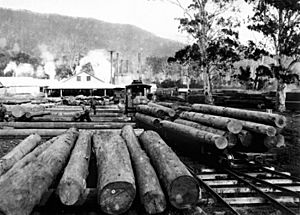
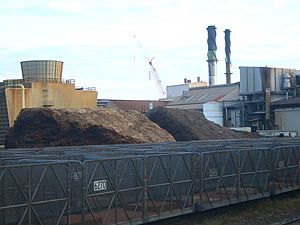
One of the first big industries in Queensland was pastoralism, which is raising livestock. This started in the Darling Downs in the 1840s. Squatters and early families set up cattle stations across the state until the 1870s. They went as far north as the Gulf Country.
The early settlers faced many challenges. These included a lack of workers and ways to transport goods to markets. They also dealt with a climate that was sometimes too wet, droughts, and falling prices for their products. A recession hit Australia in July 1866, and Queensland was affected badly. Fewer people moved to the state, unemployment rose, and businesses struggled.
But soon, gold discoveries helped the economy recover. Gold was found in Queensland in 1861 near Clermont and in 1867 at Gympie. Many gold miners moved from Victoria to Queensland in the 1870s to try their luck. During the American Civil War (1861-1865), there was a shortage of cotton in Europe. This caused a cotton boom in Queensland. Copper was also found at Cloncurry in 1869.
In 1863, the first sugar-cane farm was started. The first South Sea Islanders, called kanakas, arrived. They provided cheap labour. The sugar-cane industry grew north along the coast. A farm and mill opened in Innisfail in 1881. The next year, a mill opened in Bundaberg. By 1890, new refrigeration technology helped Queensland. It opened new markets for products that would have spoiled on the long journey to England.
In the early 1880s, the Dingo Fence was built. This fence protected livestock in southeast Australia from native dog attacks. It protected southern Queensland. The fence was kept up until the 1970s. In 2009, experts estimated that dingoes that got past the barrier caused A$60 million in losses each year in Queensland. In 1886, the introduced rabbit entered southern Queensland. This caused less pasture for livestock and led to soil erosion.
20th Century
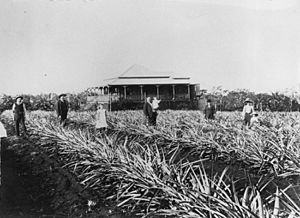
A drought in 1902 greatly reduced farm production. By 1906, maize, sugar cane, and wheat were the main crops. In 1908, 700 bores supplied water from the Great Artesian Basin to western Queensland. This helped turn dry land into more productive areas. In the same year, Queensland became Australia's largest meat exporter. This was thanks to refrigeration and regular ship services to London.
The Franco-British Exhibition in 1908 was a chance for Queensland to promote itself. It highlighted its good climate and fertile land. Tourism was promoted as "the Winter Paradise of the Southern Hemisphere." A guide from the show boasted that Queensland grew rich fruits. These included pineapples, bananas, mangoes, and citrus fruit.
Australia's largest airline, Qantas, was founded in Winton in 1920. Its original name was Queensland and Northern Territory Aerial Services. Silver, copper, and lead were mined from Mount Isa by 1925. Wool became an important export for Queensland in the early 20th century. By 1930, it made up half of the state's total exports.
The 1950s saw a return of whaling in Australia. A new whaling station was set up at Tangalooma on Moreton Island. It processed whales that were caught. In 1963, the world's richest deposit of bauxite was found at Weipa. Dairy farming, once important, declined towards the end of the 20th century. The Queensland economy last shrank in 1990-91.
21st Century
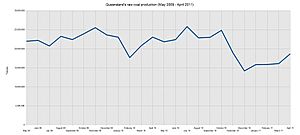
In 2004, a citrus canker outbreak forced farmers to destroy all citrus trees in the Emerald region. This meant half a million commercial trees were destroyed. The program to get rid of the disease lasted five years.
The banana industry was badly hit in 2006 by Cyclone Larry. The storm caused floods and destroyed crops. 90% of Australia's banana crop was ruined. As a result, the price of bananas doubled to A$6 a kilogram. In 2006-07, the value of Queensland's economy went over A$200 billion for the first time. In early 2009, Queensland's credit rating was lowered. This happened after the state's budget deficit grew to over A$1.5 billion.


